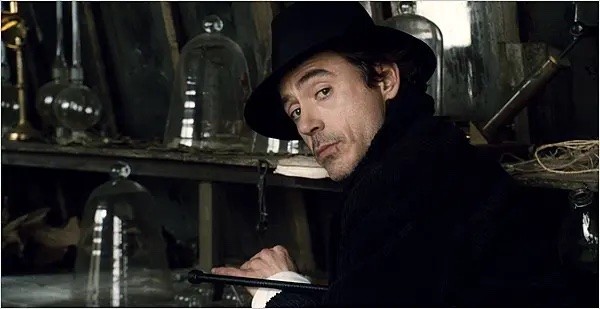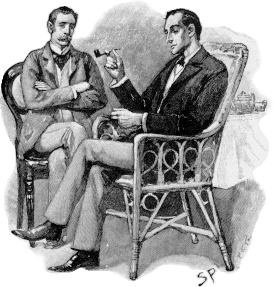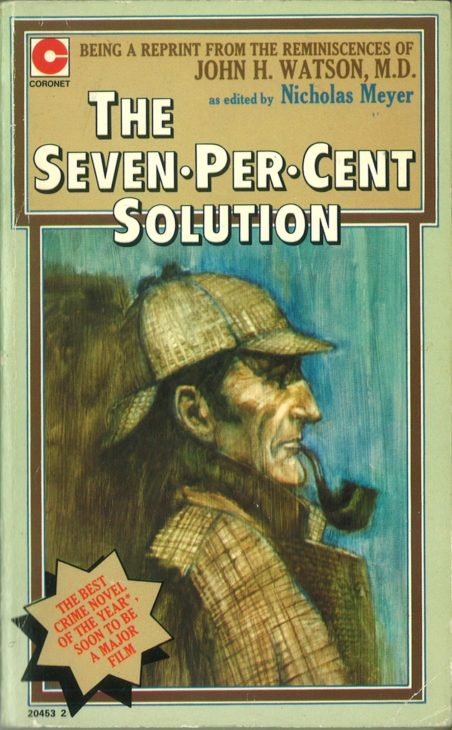
Robert Downey, Jr. as Sherlock Holmes (Warner Bros. Pictures)
“He doesn’t do cocaine in our movie.”
Those are the words of producer Lionel Wigram, responding to a question from The New York Times about drug use by Sherlock Holmes in his upcoming movie of the same name. The film stars Robert Downey, Jr. as the famous detective.
The movie is “meant for a family audience,” says The Times, which apparently is why this new Holmes is given a gambling problem instead. (Those family-friendly craps shooters!)
The question is, why are drugs being discussed at all with Holmes? How has it become part of assumed literary wisdom that cocaine addiction was a critical part of the Sherlock Holmes persona? There is little proof for this notion in the stories themselves — at least, not in the original stories by Sir Arthur Conan Doyle.
The truth is, cocaine is a very tiny part of Sherlock Holmes’s character. You could take the drug out of all the Holmes stories without significantly changing his character or the stories.
Let’s do a quick review.
The modern Holmes-as-addict meme can be traced back to the 1974 novel The Seven-Per-Cent Solution, in which Nicholas Meyer reimagined Holmes as a troubled cocaine addict who is cured by Sigmund Freud (!) before going on to do his usual mystery-solving thing.
(Not that it matters, but cocaine wasn’t illegal in the London of Holmes’s era. It wasn’t always regarded even as a vice — at the time, some doctors, Freud included, thought it might be a useful stimulant. Here’s a primer.)
Meyer got the title of his book from a moment early in the second Sherlock Holmes story, The Sign of Four, published in 1890. This is the only story where Holmes actually touches cocaine, and indeed, he does more than touch it: he injects it rather casually (in “a seven-per-cent solution”) as his sidekick Dr. Watson looks on. Furthermore, Watson says he has watched Holmes do it “three times a day for many months.”
Watson has been holding his tongue on the topic but finally states his case on the evils of the drug:
“But consider!” I said, earnestly. “Count the cost! Your brain may, as you say, be roused and excited, but it is a pathological and morbid process, which involves increased tissue-change, and may at last leave a permanent weakness.”
Holmes waves him off:
“My mind,” he said, “rebels at stagnation. Give me problems, give me work, give me the most abstruse cryptogram, or the most intricate analysis, and I am in my own proper atmosphere. I can dispense then with artificial stimulants. But I abhor the dull routine of existence. I crave for mental exaltation.”
The moment is revisited on the book’s very last page, with Watson again narrating after Holmes has (naturally) solved the crime:
“The division seems rather unfair,” I remarked. “You have done all the work in this business. I get a wife out of it, Jones gets the credit; pray what remains for you?”
“For me,” said Sherlock Holmes, “there still remains the cocaine-bottle.” And he stretched his long, white hand up for it.
So that does it: Holmes is an addict, right?
Not quite.
For one thing, those are the only two times cocaine is mentioned in the entire book. Holmes doesn’t get the jitters, doesn’t rush around looking for a fix, doesn’t mention the drug at all. Neither does anyone else. The cocaine has nothing to do with the actual tale.
Beyond that, that one moment is the only time the detective actually uses cocaine in the 60 Holmes stories and novels written by Sir Arthur Conan Doyle. The drug is mentioned only five more times in all of those 60 stories.
- In the very next Holmes tale, A Scandal in Bohemia (1891), Watson has married and moved out of their bachelor flat, but “Holmes, who loathed every form of society with his whole Bohemian soul, remained in our lodgings in Baker Street, buried among his old books, and alternating from week to week between cocaine and ambition, the drowsiness of the drug, and the fierce energy of his own keen nature.”
- In The Five Orange Pips (1891), Watson describes Holmes humorously as a “violin player, boxer, swordsman, lawyer, and self-poisoner by cocaine and tobacco.” (Notes Watson, “Holmes grinned at the last item.”)
- In The Man With the Twisted Lip (1891), Watson discovers Holmes in an opium den, posing as an addict while he chases a criminal. (“I suppose, Watson… that you imagine that I have added opium-smoking to cocaine injections and all the other little weaknesses on which you have favoured me with your medical views.”) Holmes only poses as a user here — he doesn’t smoke opium or use any other drugs in this tale.
- In The Adventure of the Yellow Face (1894), Watson describes his friend this way: “…his diet was usually of the sparest, and his habits were simple to the verge of austerity. Save for the occasional use of cocaine he had no vices, and he only turned to the drug as a protest against the monotony of existence when cases were scanty and the papers uninteresting.”
- Finally, in The Adventure of the Missing Three-Quarter (1904), Watson describes a Holmes who is no longer a user: “For years I had gradually weaned him from that drug mania which had threatened once to check his remarkable career. Now I knew that under ordinary conditions he no longer craved for this artificial stimulus, but I was well aware that the fiend was not dead, but sleeping.”
Doyle went on writing Sherlock Holmes stories for another than two decades after The Missing Three-Quarter, but never mentioned cocaine again. By contrast, Holmes’s habit of playing the violin when thinking is mentioned in 14 different stories. (Why not ask if Holmes will play the violin in the movie, New York Times?)

Sherlock Holmes (right) and Dr. Watson, in an 1893 image by Sidney Paget for Strand magazine.
Doyle himself seemed to rethink the cocaine use as he went — from the “three times a day” in The Sign of Four to “occasional use” in Yellow Face. And Holmes drops the drug immediately whenever he has a job on. That’s hardly the sign of an addict.
(A nit-picker could also note that Holmes himself never mentions any problems with his use of the drug. We see the anxiety and dismay only through Dr. Watson.)
All that said, the discussion of Holmes and his drug use is not a new one. It’s been touched on biographers and fans many times, and even The Journal of the American Medical Association published an article in 1968 titled “A Study in Cocaine: Sherlock Holmes and Sigmund Freud.” In Teller of Tales, his 2001 biography of Conan Doyle, author Daniel Stashower notes that “George Bernard Shaw once called Holmes ‘a drug addict without a single admirable trait.'”
I’ve got no problem with any of that. Here’s what does bug me: the cocaine issue seems to have grown in the past few years, from its appropriate place as a minor and curious sidelight, into some kind of major element of the Holmes personality. People talk about cocaine as if it’s Holmes’s signature trait, like Nero Wolfe and his love of food or Monk and his obsessive-compulsive disorder. That ain’t right.
It seems fair to call cocaine an unhealthy diversion for Sherlock Holmes. He is, as he says, an “occasional user.” You might even call it a habit, though it’s a habit he drops whenever he’s working. But it’s no addiction, and it’s definitely not his signature trait.
Good for Nicholas Meyer for a clever reimagining in 1974. But bad for him for starting up the modern meme of cocaine-shootin’ Sherlock.
(Note: The Searching for Sherlock database was quite useful in researching this post.)

